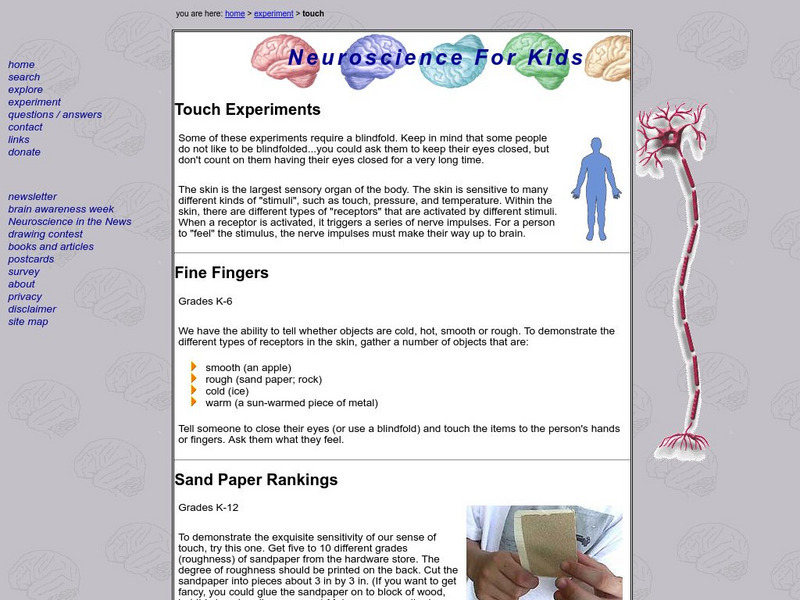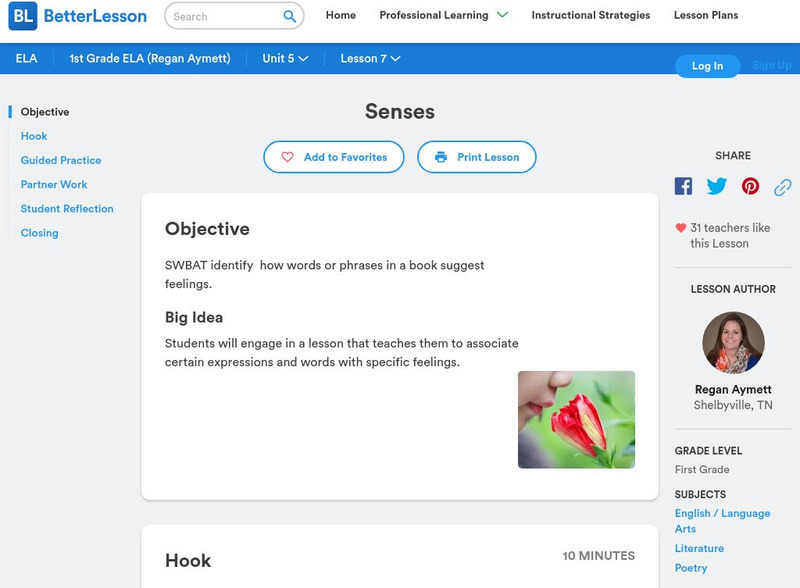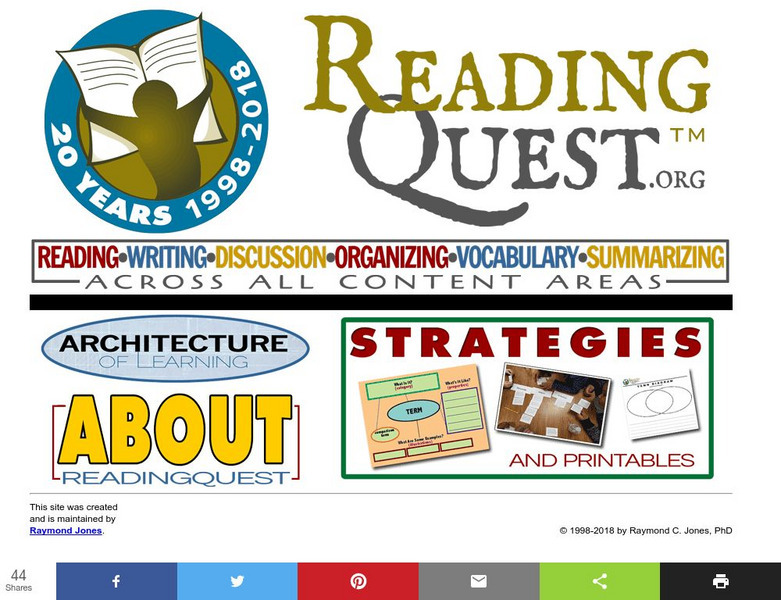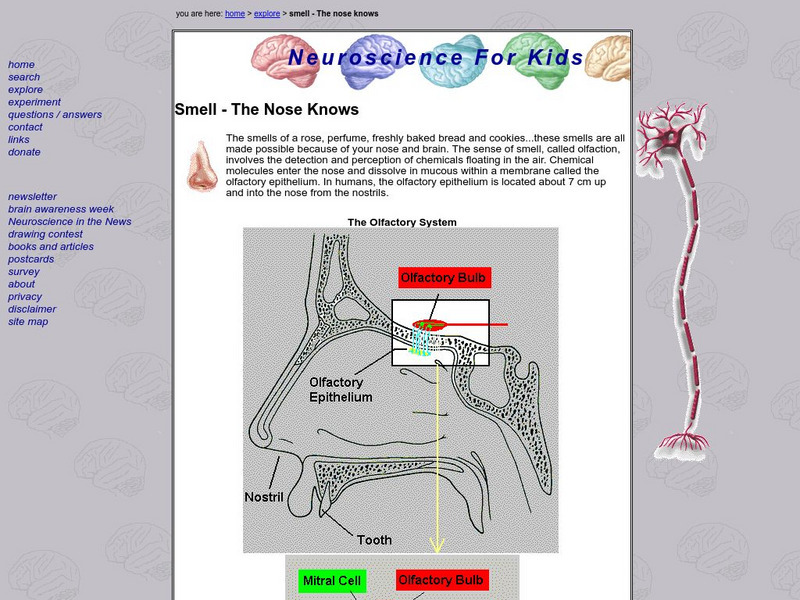American Psychological Association
Developing Adolescents
Why to young people act the way they do? Scholars investigate the stages of adolescent development incorporating high school psychology techniques. Using research from the American Psychological Association, they uncover the five areas...
University of Washington
The Senses
This site has a collection of learning activities, games, experiments, and lesson plans on the five senses. Organized by grade level and topic, this site is packed with an assortment of interactive and engaging activities, that would...
eSchool Today
E School Today: Your Revision Notes on the Five Senses
Learn how the sense organs are structured and how they function to provide you with five senses.
Frontiers Media
Frontiers: Seeing With Your Ears: A Wondrous Journey Across the Senses
For dozens of years it has been believed that the brain is organized into "sensory areas": that is, that there is a "visual area," an "auditory area," and so forth, and that the visual area can only process visual information. It has...
Scholastic
Scholastic: Study Jams! Science: The Human Body: The Senses: Touching
Self-playing slideshow, with an accompanying quiz, explains how the skin, as a sense organ, allows us to touch and feel.
University of Washington
University of Washington: Neuroscience for Kids: Smell Experiments
Describes experiments students can do to investigate the sense of smell. The experiments target either grades K-6 and 3-12.
McGraw Hill
The Mc Graw Hill Companies, Inc.: Sense of Smell
This informative site provides information on the olfactory receptors, olfactory epithelium, and olfactory bulb. Detailed drawing supplement the text along with an animation that depicts the movement of molecules through the nose.
Mind My Education
Mind My Education: The Life of Environments
This extensive lesson plan covers various topics about how animals interact with their environment. Topics include how animals sense their environment, how environments and organisms change together, and how animals use their senses to...
University of Washington
University of Washington: The Senses Touch
Do you know what the largest sensory organ of the body is? Use this site on skin and its sense of touch to learn more.
Better Lesson
Better Lesson: Senses
Students will engage in a lesson that teaches them to associate certain expressions and words with specific feelings. Included are a senses PowerPoint, a model of a graphic organizer, and a video and picture of the students engaged in...
BioEd Online
Bio Ed Online: The Brain: Control Central
What do you know about the brain? In this early learners instructional activity, students will explore the basic functions and characteristics of the brain and skull, and also learn about three major structures in the brain: the...
California Institute of Technology
Infrared Zoo Lesson 2: Dinner in the Dark
After exploring the scenario of how a pit-viper may get his midnight snack, students learn about the infrared sense of a pit-viper. They then discuss how infrared technology has helped in our society.
Hunkins Experiments
Hunkin's Experiments: How to Map Your Sense of Touch
Hunkin's Experiments is a group of simple cartoon illustrations of scientific principles. Some would work well in the classroom, but others have little value beyond entertaining students. All of the projects are easy to do. This would be...
Other
Reading Quest: Making Sense of Social Studies
Teaching students to read well in areas other than language arts requires teaching and reinforcing the kinds of reading strategies taught here. There are 27 strategies, ranging from brainstorming to word mapping. The site includes PDF...
TeachEngineering
Teach Engineering: Sensing Air Pollution
Students learn about electricity and air pollution while building devices to measure volatile organic compounds (VOC) by attaching VOC sensors to prototyping boards. In the second part of the activity, students evaluate the impact of...
PBS
Nova: The Hunt
Learn more about the six senses that sharks use to hunt. Descriptions and pictures of each sensory organ are provided.
Common Sense Media
Common Sense Media: Education: Story Elements Retelling
In this lesson, students will learn to retell a story using story elements to improve their comprehension of the story. The students will actively listen to a story and complete a graphic organizer to share and discuss with a partner.
University of Washington
University of Washington: Nose Structure and Function
Discusses how the structures of the noseinteract to produce our sense of smell.Has links to lab activities and teacher lessonson this topic.
Other
Science Blogs: Adventures in Ethics and Science: Basic Concepts: Norms of Science
Explains what Robert K. Merton meant by the norms of science, and summarizes the four norms highlighted by Merton. These are Universalism, 'Communism' or the sense of being part of a community, Disinterestedness, and Organized...
Wolfram Research
Wolfram Math World: World's Most Extensive Mathematics Resource
MathWorld provides a huge mathematics encyclopedia detailing the concepts of geometry, algebra, calculus, discrete math, number theory, and other math topics--complete with formulas, diagrams, examples, and references for thorough...
Curated OER
The Senses
This site has a collection of learning activities, games, experiments, and lesson plans on the five senses. Organized by grade level and topic, this site is packed with an assortment of interactive and engaging activities, that would...
Curated OER
The Senses
This site has a collection of learning activities, games, experiments, and lesson plans on the five senses. Organized by grade level and topic, this site is packed with an assortment of interactive and engaging activities, that would...
Curated OER
The Senses
This site has a collection of learning activities, games, experiments, and lesson plans on the five senses. Organized by grade level and topic, this site is packed with an assortment of interactive and engaging activities, that would...
Writing Fix
Writing Fix: Colorful Sensory Poems
This lesson allows students to explore color - both in literal and figurative terms. Students will read books about color, discuss the emotion involved with color, and incorporate color metaphors to write poems using the graphic...



















